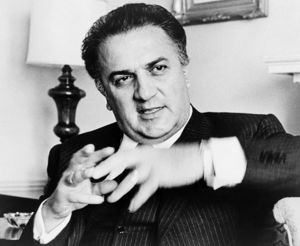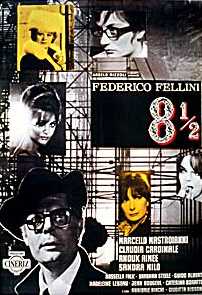Federico Fellini
Federico Fellini (Italian: [fedeˈri"ko felˈli"ni]; ✦20 January 1920 – †31 October 1993) was an Italian film director and screenwriter. Known for his distinct style that blends fantasy and baroque images with earthiness, he is recognized as one of the most influential filmmakers of all time. Some of his films are placed in polls such as in "Cahiers du cinéma" and "Sight & Sound" as some of the greatest films of all time, with his 1963 film "8½" being listed as the 10th greatest film of all time by Sight & Sound.
In a career spanning almost fifty years, Fellini won the Palme d'Or for "La Dolce Vita," was nominated for twelve Academy Awards, and directed four motion pictures that won Oscars in the category of Best Foreign Language Film. In 1993, he was awarded an honorary Oscar for Lifetime Achievement at the 65th Annual Academy Awards in Los Angeles.
Beyond neorealism (1954–1960)
With Pinelli, Fellinni developed "Journey with Anita" for Sophia Loren and Gregory Peck. An "invention born out of intimate truth", the script was based on Fellini's return to Rimini with a mistress to attend his father's funeral. Due to Loren’s unavailability, the project was shelved and resurrected twenty-five years later as "Lovers and Liars" (1981), a comedy directed by Mario Monicelli with Goldie Hawn and Giancarlo Giannini. For Eduardo De Filippo, he co-wrote the script of "Fortunella", tailoring the lead role to accommodate Masina’s particular sensibility.
The "Hollywood on the Tiber" phenomenon of 1958 in which American studios profited from the cheap studio labor available in Rome provided the backdrop for photojournalists to steal shots of celebrities on the via Veneto. The scandal provoked by Turkish dancer Haish Nana’s improvised striptease at a nightclub captured Fellini’s imagination: he decided to end his latest script-in-progress, "Moraldo in the City", with an all-night "orgy" at a seaside villa. Pierluigi Praturlon’s photos of Anita Ekberg wading fully dressed in the Trevi Fountain provided further inspiration for Fellini and his scriptwriters. Changing the title of the screenplay to "La Dolce Vita," Fellini soon clashed with his producer on casting: the director insisted on the relatively unknown Mastroianni while De Laurentiis wanted Paul Newman as a hedge on his investment. Reaching an impasse, De Laurentiis sold the rights to publishing mogul Angelo Rizzoli. Shooting began on 16 March 1959 with Anita Ekberg climbing the stairs to the cupola of Saint Peter’s in a mammoth décor constructed at Cinecittà. The statue of Christ flown by helicopter over Rome to Saint Peter's Square was inspired by an actual media event on 1 May 1956, which Fellini had witnessed. The film wrapped August 15 on a deserted beach at Passo Oscuro with a bloated mutant fish designed by Piero Gherardi.
"La Dolce Vita" broke all box office records. Despite scalpers selling tickets at 1000 lire, crowds queued in line for hours to see an “immoral movie" before the censors banned it. At an exclusive Milan screening on 5 February 1960, one outraged patron spat on Fellini while others hurled insults. Denounced in parliament by right-wing conservatives, undersecretary Domenico Magrì of the Christian Democrats demanded tolerance for the film’s controversial themes. The Vatican's official press organ, "l'Osservatore Romano", lobbied for censorship while the Board of Roman Parish Priests and the Genealogical Board of Italian Nobility attacked the film. In one documented instance involving favorable reviews written by the Jesuits of San Fedele, defending "La Dolce Vita" had severe consequences. In competition at Cannes alongside Antonioni’s L’Avventura, the film won the Palme d'Or awarded by presiding juror Georges Simenon. The Belgian writer was promptly “hissed at" by the disapproving festival crowd.
Art films and dreams (1961–1969)
A major discovery for Fellini after his Italian neorealism period (1950–1959) was the work of Carl Jung. After meeting Jungian psychoanalyst Dr. Ernst Bernhard in early 1960, he read Jung's autobiography, "Memories, Dreams, Reflections" (1963). Bernhard also recommended that Fellini consult the 'I Ching' and keep a record of his dreams. What Fellini formerly accepted as "his extrasensory perceptions" were now interpreted as psychic manifestations of the unconscious. Bernhard’s focus on Jungian depth psychology proved to be the single greatest influence on Fellini’s mature style and marked the turning point in his work from neorealism to filmmaking that was "primarily oneiric". As a consequence, Jung's seminal ideas on the anima and the animus, the role of archetypes and the collective unconscious directly influenced such films as "8½" (1963), "Juliet of the Spirits" (1965), "Fellini Satyricon" (1969), "Casanova" (1976), and "City of Women" (1980). Other key influences on his work include Luis Buñuel, Charlie Chaplin, Sergei Eisenstein, Buster Keaton, Laurel and Hardy, the Marx Brothers, and Roberto Rossellini.
Exploiting "La Dolce Vita’s" success, financier Angelo Rizzoli set up Federiz in 1960, an independent film company, for Fellini and production manager Clemente Fracassi to discover and produce new talent. Despite the best intentions, their overcautious editorial and business skills forced the company to close down soon after cancelling Pasolini’s project, Accattone (1961).
Condemned as a "public sinner" for La Dolce Vita, Fellini responded with The Temptations of Doctor Antonio, a segment in the omnibus Boccaccio '70. His first color film, it was the sole project green-lighted at Federiz. Infused with the surrealistic satire that characterized the young Fellini’s work at Marc’Aurelio, the film ridiculed a crusader against vice, interpreted by Peppino De Filippo, who goes insane trying to censor a billboard of Anita Ekberg espousing the virtues of milk.
In an October 1960 letter to his colleague Brunello Rondi, Fellini first outlined his film ideas about a man suffering creative block: "Well then - a guy (a writer? any kind of professional man? a theatrical producer?) has to interrupt the usual rhythm of his life for two weeks because of a not-too-serious disease. It’s a warning bell: something is blocking up his system." Unclear about the script, its title, and his protagonist’s profession, he scouted locations throughout Italy “looking for the film" in the hope of resolving his confusion. Flaiano suggested, "La Bella Confusion" (literally "The Beautiful Confusion") as the movie’s title. Under pressure from his producers, Fellini finally settled on "8½," a self-referential title referring principally (but not exclusively) to the number of films he had directed up to that time.
Chat rooms • What links here • Copyright info • Contact information • Category:Root

